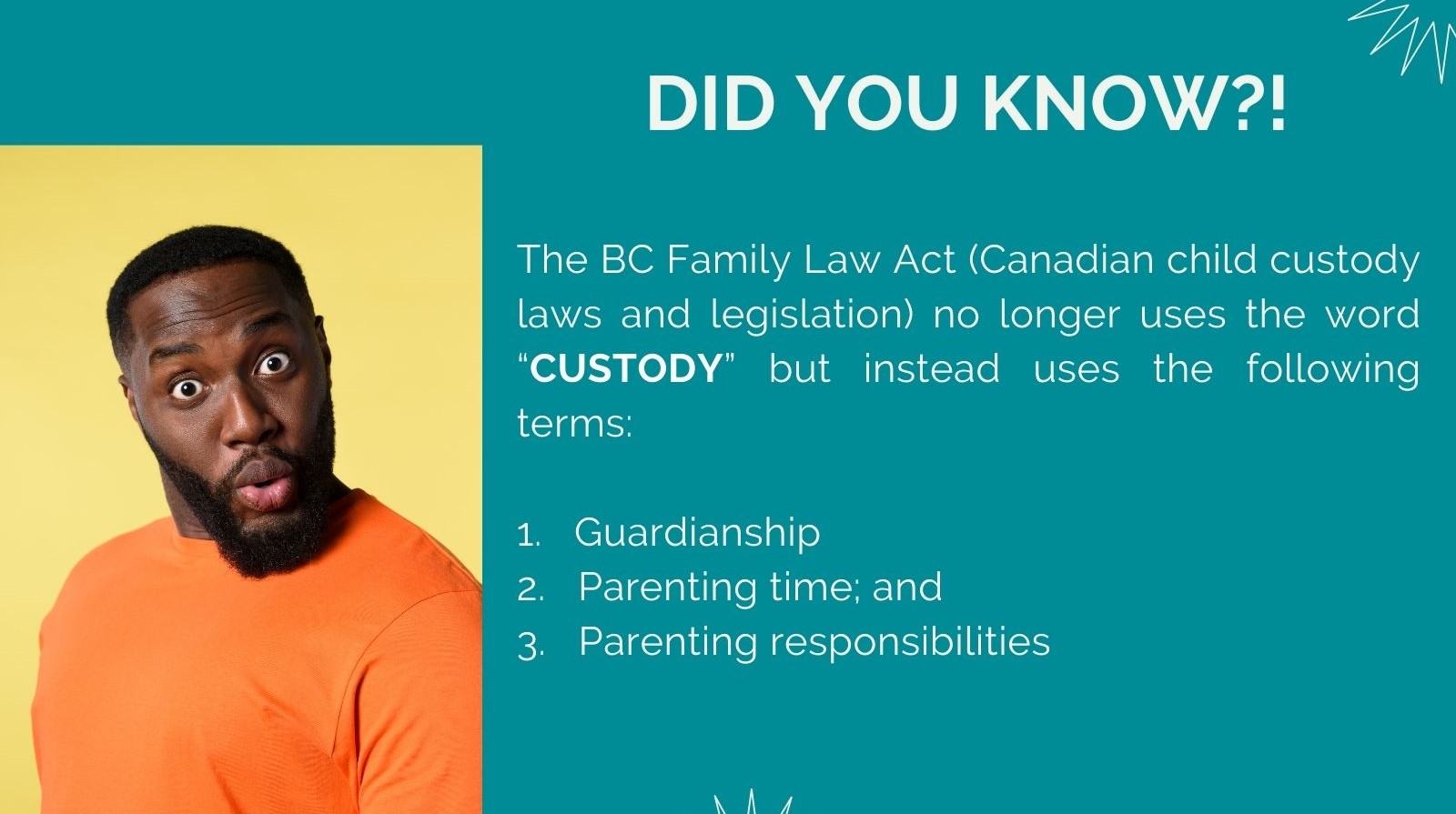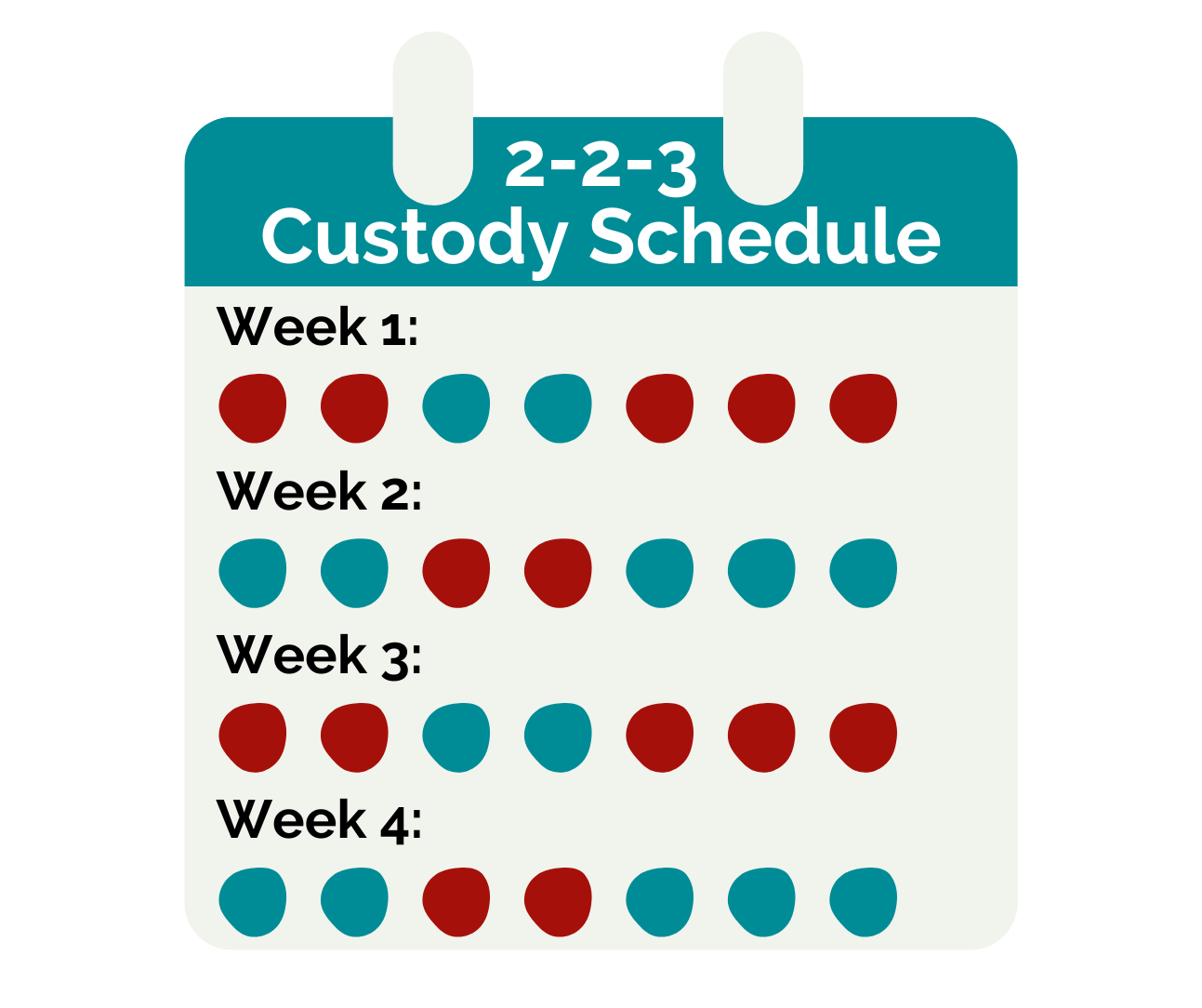Discover more. If your divorce is inevitable, choose the BETTER Path: join our newsletter for supportive, resolution-focused information!
Child Custody Schedules - Which is the Best Schedule for Kids?
- Home
- Getting Custody
- Custody Schedules

Child custody schedules in BC have many variations. The BC Family Law Act is the governing legislation regarding BC family law and it starts from the premise that children are entitled to be with both of their parents.
A clear co-parenting schedule provides a structure for kids and increases their sense of safety and well-being. Even when kids are relatively young, they can understand and benefit from the predictability of set schedules.
Quick Links
What is a 2-2-3 Custody schedule?
The 2-2-3 custody schedule is particularly popular for parents with younger children. It is a way of having a 50-50 schedule, but without there being too long of a break between the children spending time with each parent. Think of the week like this . . . Monday/Tuesday with Mom, then Wednesday/Thursday with Dad, then Friday through Sunday with Mom. The next Monday/Tuesday is now with Dad, and so on. This way the kids get to enjoy a full weekend with each parent every second weekend.
When kids are young, this kind of schedule can be really beneficial because it allows for frequent contact with each parent each week, but it does take a fair amount of agreement between parents, however. For example, we are sad to say that there are some instances where the parents will not agree on extra-curricular activities. So, for example, if one parent supports the child being in swimming lessons on Mondays and the other parent doesn’t participate, the child ends up missing their swimming lessons every second week. Yes, we are sad to say that some parents are jerks like that.
What is a 50-50 Custody schedule?
There are many variations of 50-50 custody schedules. They include what is commonly referred to as week on and week off, 4 on 4 off, 2/2/3 (as stated above), 2/2/5 and so on. The point is that when parents share a 50-50 custody schedule they work it out so that each parent has the children in their care exactly half of the time according to a set schedule based upon the days of the week.
For example, a 2/2/5 schedule operates on a two-week cycle that allows parents to have a 50-50 custody schedule, but each parent has the child for specific days of the week. Here is an example of what it can look like:
Week 1:
🟢 Monday and Tuesday: The child stays with Parent A
🟢 Wednesday and Thursday: The child stays with Parent B
🟢 Friday, Saturday, and Sunday: The child stays with Parent A
Week 2:
🟢 Monday and Tuesday: The child stays with Parent B
🟢 Wednesday and Thursday: The child stays with Parent A
🟢Friday, Saturday, and Sunday: The child stays with Parent B
What is a 60-40 Custody schedule?
Sometimes equal child custody schedules do not work for a family. The exact 50-50 custody schedule does not logistically work when there are constraints on a parent’s time, because of their work schedule, for example.
Because of such constraints, the parents might opt for a 60- 40 custody schedule, thus allowing predictability and substantial time with their kids while making room for constraints on their time.
60-40 Child custody schedules can be when parent A has the child in their care from Mondays to Wednesday mornings and the balance of the week is spent with the other parent, from Wednesday afternoon until Sunday evening.
What is a 70-30 Custody schedule?
With 70-30 child custody schedules, one parent has the child for 70% of the time, while the other parent has the child for 30%. Just like the 60-40 custody schedule, the 70-30 schedule is utilized in cases where one parent's work or travel commitments make it difficult to have an equal split of time. Having a consistent schedule allows for a meaningful and consistent relationship between the child and both parents, although one parent will end up with more parenting time.
What is a Child custody holiday schedule?
So, now that we have reviewed the regular child custody schedules, those schedules being regular on a weekly or 14-day cycle, we can now take a look at what a child custody holiday schedule looks like.
There are always special occasions, special days, holidays, and the like. Regardless of a family’s religion, parents often want to take advantage of holidays throughout the year, that is why child custody schedules often include holidays.
In BC, it goes without saying that the BIG one is Christmas. Throughout the years, we have always noticed that parents really enjoy seeing their children wake up on Christmas morning. One of the disadvantages is that when you have gone through a divorce, you are likely going to have to share your kids with the other parent over Christmas. That is why in most cases, parents depart from the usual child custody schedule at Christmas.
In most cases this is what we say in the child custody agreements (we will call the parents Cindy & Elf).
The parties will depart from the usual parenting schedule as follows:
In odd-numbered years, Cindy will have the children in her care from noon on Christmas eve until noon on December 26. Elf will have the children from noon on December 26 until noon on December 28, at which time the parties will revert to the usual parenting schedule.
In even-numbered years Elf will have the children in his care from noon on Christmas eve until noon on December 26. Cindy will have the children from noon on December 26 until noon on December 28, at which time the parties will revert to the usual parenting schedule.
Another Christmas schedule goes like this:
The parties will equally share the children's Christmas Break. The children will stay with Elf for the first half of the Christmas Break in odd-numbered years and the last half of the Christmas Break in even-numbered years, and with Cindy for the first half of the Christmas Break in even-numbered years and the last half of the Christmas Break in odd-numbered years. The first half will start after school on the last day of school in December and end at noon on the date that is the half way point of the Christmas Break. The second half will start at noon on the date that is the half way point of the Christmas Break and end at the start of school on the January return date.
There are of course other holidays to consider (some of which really are all about enjoying long weekends and extra fun time with kids who are off school):
Easter weekend, spring break, summer holidays, Thanksgiving weekend, Family Day weekend, Mother’s Day, Father’s Day and Hallowe’en.
Other families might honour these holidays and want to incorporate these special days/times into their child custody schedules:
Passover, Rosh Hashana, Yom Kippur, Sukkot, Eid al-Fitr, or Eid al-Adha.
Every family is different, and some people like the consistency of a regular schedule throughout the year, while others want to make special occasions memorable, and those memories include them wanting special times with their kids. It all depends on a family’s unique circumstances.
Important Related Pages
First right of refusal custody - What is that?
Sometimes a parent is unable to care for the child during their parenting time. This is when first right of refusal custody comes in. Basically, this type of arrangement requires that a parent, if they will be unavailable for any reason, must first offer parenting time to the other parent rather than having a third-party caregiver care for the child.
Most of the time, there is a timeline set, like four hours or more. For example, if a parent has to run out to the store for 20 minutes, they might leave the child at home with their new partner and come right back. In that case, it doesn’t make sense that the other parent is called to care for the child. However, and unfortunately, we just saw a sample of this recently, a parent went out for an entire day of playing golf. That parent left his 3-year old in the care of a third party for more than nine hours. Rather than offering that parenting time to the mother, who was ready, able and very much wanting to spend the day with the child, the parent chose a third-party to care for the child instead because it was “his” parenting time. This is a perfect example of when first right of refusal custody should be utilized.
Co-parenting after divorce - child custody schedules can be as unique as each family

One example we see of child custody schedules that have built-in both consistency and flexibility is when a parent is in the military. For example, when one parent is deployed for months at a time, they will have almost no time with their children, but when they are returned home for months, the parents then enter into a more shared parenting-time arrangement.
Kids thrive when their schedules are clear, not only to their parents but to them. That is why we suggest parents use a colour-coded calendar for little kids and clearly communicate the schedule (and any anticipated changes) to older kids.
When establishing a co-parenting schedule, it can be helpful to use a template as a starting point. A child custody schedule template provides a framework for parents to create a personalized schedule that fits their specific circumstances. It outlines the days and times when the child will be with each parent, making it easier to coordinate schedules and plan other activities. A custody schedule template can also serve as a reference point for addressing any conflicts or disputes that may arise in the future.
Of course, in BC, child custody arrangements should always prioritize the child's best interests. Factors such as the child's age, relationship with each parent, school schedule, and extracurricular activities must be considered.
One of the things that must be considered is that child custody schedules impact the amount of child support that must be paid.
For example, in the case of 50 50 child support, a parent’s obligation to pay child support will be reduced when there is shared care.
How does child support work with child custody schedules?
In BC, if a parent does not have their child in their care at least 40% of the time according to their child custody schedule, then they will pay support based upon the Federal Child Support Guidelines. The amount of support to be paid by that parent is based on their income.
50 50 custody child support, for example, is when parents share the children equally, but often they think that when they have this kind of child custody schedule, that neither parent will pay child support to the other. In BC, this is not always the case. For example, if one parent makes $30,000 per year, and the other, $250,000 per year, the higher income earning parent will still, in almost all circumstances, pay the lower income earning parent child support. In Canadian child custody laws we call it a “set off” amount of support. It helps equalize the resources between the households. That way a child will not have a drastically different lifestyle between each of their parents’ homes.
On the other hand, for a lot of parents, paying child support can create significant financial consequences, particularly if they live in expensive cities like Vancouver or Victoria. For the recipient parent, the amount of child support is often something they very much count on in order to pay for their housing costs.
Although we never want to see a “tail wagging the dog” - type situation – that is parents first trying to figure out how to reduce their child support obligation and only then determining the schedule, the amount of child support payable can be a very real factor that significantly impacts parents and their financial circumstances.
This is yet another reason why child custody schedules are so important and must be well-thought-out.
Summary of child custody schedules
Those are the various child custody schedules. It's important to have a clear co-parenting schedule that provides a structure for kids and increases their sense of safety and well-being. Even when kids are relatively young, clear, predictable schedules are easy for them to understand.











